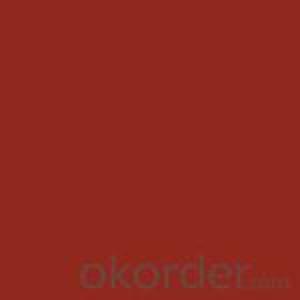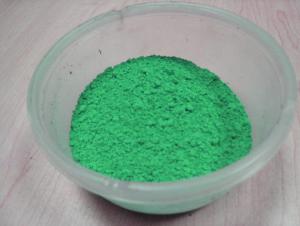Cadmium Blue Acid Resistant Pigment Nanotmeter
- Loading Port:
- Tianjin
- Payment Terms:
- TT OR LC
- Min Order Qty:
- 500 kg
- Supply Capability:
- 6000000 kg/month
OKorder Service Pledge
OKorder Financial Service
You Might Also Like
Specifications of Cadmium Bule:
PB28 Cobalt Blue Acid Resistant Pigment
- High temperature pigment
- Non-toxic pigments
- Anti-far-infrared function
CNBM is one of the biggest inorganic pigments manufacturer in china, specialized in producing mixed metal oxide pigments with the advantages of Acid Resistance, High Temperature Resistance, Excellent Tinting Strength, Easy to be dispersed.
Descriptions of PB28 Cobalt Blue Acid Resistant Pigment :
Cobalt Aluminate Blue Spinel, Pigment Blue 28, high temperature resistant pigment, cadmium bule is a bright color with reddish blue, which has a special anti-far-infrared function. Cadmium bule is also one kind of environmental protection pigments, which is internationally recognized as non-toxic pigments. It is easy to disperse, with excellent heat resistance, weather resistance, acid & alkali resistance, and resist to a variety of solvents, good hiding power.
Chemical Name: Cobalt Aluminate Blue Spinel
Chemical Composition: Co/Al Oxide
Color Index Name: Pigment Blue 28 / P.B.28
Color Index Number: 77346
CAS Number: 1345-16-0
Physical Form: Blue Powder
Crystal Pattern: Spinel Pattern
Cadmium Blue Technical Specifications:
Model No. | Particle Size (μm) ≤ | Heat Resistance (℃)≥ | Weather Resistance (Grade)1-5 | Lightfastness (Grade) 1-8 | Acid Resistance (Grade) 1-5 | Alkali Resistance (Grade) 1-5 | Oil Absorption g/100g | Density g/cm3 | PH |
JF-B2805 | 2.5 | 1200 | 5 | 8 | 5 | 5 | 28-37 | 3.8-5.4 | 6-9 |
Cadmium Blue Regulations:
EU RoHS Directive 2002/95/EC | Compliant |
EN71Part 3:1994 (A1:2000/AC2002) | Compliant |
US FDA 21 CFR 177.1520 | Compliant |
ASTM F963-08 (Clause 4.3.5) | Compliant |
REACH | Compliant |
Cadmium Blue Applications:
Cadmium Blue is mainly used in high temperature (resistant) coatings, ceramics, enamels, glass coloring, coloring of high temperature resistance engineering plastics,food contact plastics,as well as art paint.
Model with A, B represent fine type and standard type respectively.



- Q: Can some one suggest chemical pigments that can be easily made from chemicals available in a chemistry lab for a project?I need the name of the pigment, reactants required and chemical equations of reactions involved.I need atleast 5 pigments
- Some pigments easy to make in a school laboratory: 1) Calcium carbonate: Mix solutions of calcium chloride and sodium carbonate : CaCl2(aq) + Na2CO3(aq) → CaCO3(s) + 2NaCl(aq) filter off and dry the calcium carbonate 2) Barium carbonate Exactly as above , but start with barium chloride 3) Calcium sulphate Mix solutions of calcium chloride and sodium sulphate: CaCl2(aq) + Na2SO4(aq) → CaSO4(s) + 2NaCl 4) Barium sulphate Use barium chloride instead of calcium chloride . 5) Satin white is another interesting pigment: Mix solutions of aluminium sulphate and calcium hydroxide with strong stirring , You get a paste which is a mixture of aluminium hydroxide and calcium sulphate . There is no specific formula because what you get depends on how you mix. Do not try and dry this out to get a dry pigment - it does not work. There are 5 white pigments that you can easily make - but remember to wear proper protective clothing when working with all chemicals
- Q: what are the accessory pigments in plant photosynthesis?
- Accessory Pigments In Photosynthesis
- Q: What does pigment mean?
- The natural coloring matter
- Q: If you could explain it to me I would be very happy!
- Accessory pigments are light-absorbing compounds, found in photosynthetic organisms, that work in conjuction with chlorophyll a. They include other forms of this pigment, such as chlorophyll b in green algal and higher plant antennae, while other algae may contain chlorophyll c or d. In addition, there are many non-chlorophyll accessory pigments, such as carotenoids or phycobiliproteins which also absorb light and transfer that light energy to photosystem chlorophylls. Some of these accessory pigments, particularly the carotenoids, also serve to absorb and dissipate excess light energy, or work as antioxidants.
- Q: I want to find bright colored eye pigments much like macs. However I dont want to spend tons of money. Does anyone know of a place that sells inexpensive eyeshadow pigments?
- Go to Wal-mart or Target and look at their selections. A lot of cosmetic lines are now into making eye shadow pigments!!
- Q: What does it mean when something is highly pigmented?
- PIGMENTED = A HIGH SATURATION OF COLOUR
- Q: i was thinking of this all day long and then i thought of posting this question for you to help me sort it out
- Pigments are chemicals inside living things that absorb certain types of light. In plants, the pigment chlorophyll in leaves absorbs sunlight for photosynthesis to work, where the energy comes from. Chlorophyll absorbs all light except green, which is reflected. That's why most plants are green. NOT the other war around. :) :)
- Q: Can someone describe the role of accessory pigments in photosynthesis?
- Accessory Pigments In Plants
- Q: What pigments take part in photosynthesis?
- The green chlorophyll a & b
- Q: Many of the microorganisms found on environmental surfaces are pigmented. Of what possible advantage is the pigment?
- So they can absorb different light frequencies to use for energy (from photosynthesis). Light travels in water according to the frequency (wavelength). So different pigmented organisms are able to exist in different environments, possibly reducing competition with other forms.
Send your message to us
Cadmium Blue Acid Resistant Pigment Nanotmeter
- Loading Port:
- Tianjin
- Payment Terms:
- TT OR LC
- Min Order Qty:
- 500 kg
- Supply Capability:
- 6000000 kg/month
OKorder Service Pledge
OKorder Financial Service
Similar products
Hot products
Hot Searches
Related keywords

























